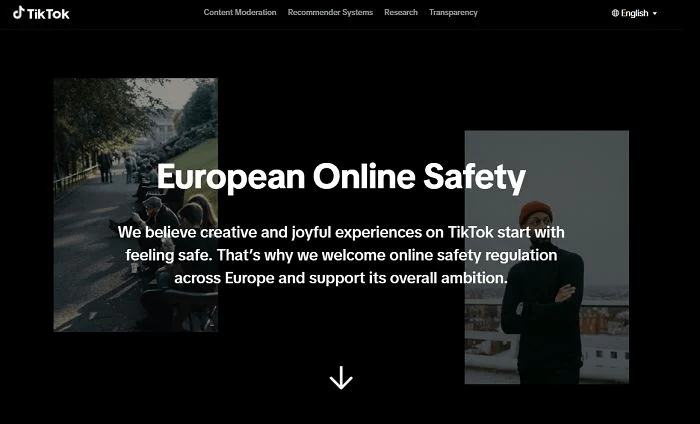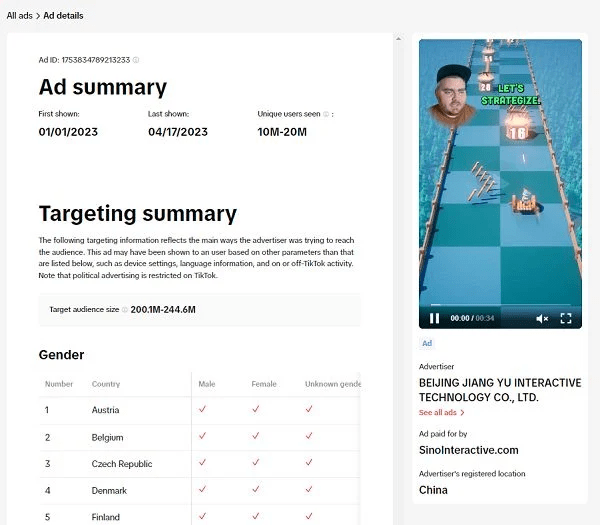TikTok Prioritize User Rights with Revised DSA Standards in the EU
TikTok has provided a list of the numerous measures it is taking to comply with the revised Digital Services Act (DSA) standards. The action was taken in response to the EU’s declaration that, as part of the app’s DSA compliance, European users would soon have the option to reject algorithmic personalization. User rights will be better safeguarded thanks to the EU DSA, which will soon go into effect. This is especially relevant to how personal data is used. Additionally, it will make it possible for firms to compete fairly in the digital space. Now, each platform must give users additional information about how they use their data and give them the option to opt-out if they so want.
EU Safety Hub
TikTok has introduced a fresh EU Online Safety Hub. This is in addition to turning off customization and returning users to a popular content feed (based on regional patterns). It will give a thorough rundown of all the components of TikTok’s DSA compliance along with information on each.

Image credit- Social Media Today
Access to all of TikTok’s reporting and transparency tools will be available through the newly launched EU Security Hub. It will contain information on its algorithms’ inner workings, how content is moderated, statistics on ad targeting, and more. The majority of the segment’s links lead back to the already-existing Help Centre pages. Moreover, it offers a useful overview of all of TikTok’s numerous measures. As a result, there are not many original insights.

Image credit- Red Mention
Read More: Meta to Offer Ad-Free Subscription Plans For European Users
Noteworthy measures:
1. Reporting allegedly illegal content
This extra reporting tool enables users to report what the EEA considers illegal content, including advertising. The Community Guidelines and Ad Policies are the benchmark to review and examine any content reported. If found to be in violation of the policies, it will be removed globally. Furthermore, the brand-new, extra-dedicated team of moderators and legal experts will examine the content to see if it violates national laws. If it does, nations will no longer have access to the blocked content. The decision will be communicated to both the individual who uploaded the information and the person who disputed it, with the option of review should they object.
2. Recognized feed
European users can disable personalization to have the ‘For You‘ and LIVE feeds promote videos that are both regionally pertinent and widely popular rather than content tailored to their individual interests. Similar to how they would receive results from a non-personalized search, users would see information that is popular in their area and in their language of choice.
3. Commercial media library
This searchable database provides details on sponsored advertisements on TikTok and ad metadata, including the advertising creative, dates the ad appeared, and the primary targeting criteria
4. API research privileges
In an effort to increase TikTok content transparency, European academics could access applications for research on the platform from early August.
5. Commercial content labeling
It now provides a variety of labels that people and corporations can attach to their material to make it apparent to the global audience that the material is of a commercial nature. The label options include ad/sponsored (advertiser-paid content), paid partnership (a commercial partnership between an individual and a brand), or promotional content (organic content by an individual/business used to promote their own brand, product, or service).
6. Limited tailored advertisements for U18s
Personalized ads are no longer available for European users between the ages of 13 and 17.
Read More: Meta Adopts Consent Policy for Targeted Ads Data in Europe
How will the DSA revisions impact the advertiser experience?
The DSA has already significantly impacted the way services report their data usage. Therefore, it will be curious to watch if the extra notes influence how consumers let apps track and use their details if indeed it does so. Undoubtedly, more information is preferable, but alternatives like turning off the algorithm, which works similarly to turning off ad personalization, are probably more appealing in theory. Additionally, for brands, these novel measurements may provide a variety of fresh insights regarding rival strategies, ad targeting alternatives, etc. Moreover, expanded data access could aid by illuminating the methods leading companies use to engage consumers in the app.
With all of this in mind, TikTok developed novel compliance procedures that may alter the platform’s entire user experience and limit advertiser reach. They will have a safe media environment to invest in while this is happening. TikTok asserts to have 134 million users across Europe. Following the EU’s implementation of DSA, it has finally complied with the recently implemented transparency rules. Additionally, these developments are benefiting advertisers. This holds especially true since the implementation of age restrictions and content reports. More risk-averse companies are probably going to invest in the platform more broadly.
Here’s what they said
As reported by AdWeek, Costas Tsiappourdhi, social product partner at media agency Brainlabs stated,
The ability to opt out of content personalization is particularly interesting for a platform that has built its business and brand on delivering highly personalized content to its users. While this could see a change in how those users engage, I expect, in practice, that TikTokers will be reluctant to part ways with their algorithmically curated For You pages, resulting in fewer opt-outs overall.
Aengus Boyle, senior director for media at VaynerMedia London added,
With consumer trust in big platforms having been eroded over the past few years, steps like this are essential to empower and inform consumers. The new commercial content library is also an exciting prospect for those interested in seeing how other advertisers are activating on the platform, giving a view into creatives being run, flight dates, and details around targeting parameters leveraged.
Read More: NYC Bans TikTok On City-Issued Devices Amid Security Concerns
AdForm Set To Solve The Cookie Problem With Its Proven First-Party ID Solution
Adform announced this week that advertisers can now use the first-party ID on their platform in the absence of third-party cookies. The demise of third-party cookies has been a cause of concern for all advertisers and publishers on some browsers and are looking to future-proof their offerings and tech stacks. And Adform’s success in switching to first-party data is a major breakthrough for the industry. Now, agencies can share first-party data and IDs with Adform to personalize advertising, target specific audiences, and report results – all without the use of any third-party cookies.
A joint collaboration between Adform, the European publishing group Sanoma, marketing agency Dagmar, and global group IPG MediaBrands is leading the way forward for the digital advertising industry and leveling the playing field with the walled gardens. The collaboration not only prepared for the future cookie change but also improve the functionality of advertising buying for Safari and Firefox browsers. The change in first-party data allows programmatic targeting and helps to direct advertising money into publishers’ properties who are eager to secure their ad revenue.
Adform states that without the need for hundreds of third-party cookies, compliance with regulations such as GDPR and CCPA will be easier. First-party data and IDs is beneficial to brands as they live longer than third-party cookies. With first-party IDs from publishers and advertisers, impressions and data are completely traceable increasing transparency that helps to deal with issues like discrepancies, accountability, hidden fees, arbitrage, and ad fraud and reducing the risk of data leakage.
Adform has a complete digital infrastructure and is uniquely placed to switch to first-party data with its integrated advertising platform(IAS). Jakob Bak, CTO, Adform said,
“We have proved that it is possible to switch from third-party cookies to first-party IDs and, as such, have provided a leap into the future of digital marketing. The industry is on an inevitable road to life without third-party cookies and ongoing success for the open ecosystem will depend on collaboration. So far, publisher announcements around first-party data have represented positive yet individual approaches, now it’s clear that working together presents a more powerful way to ensure profitability for independent publishers. In fact, the evidence of how impactful shared first-party IDs can be has already led to many agencies and sales houses to express interest in moving spend away from media giants.”
Jaakko Kuivalainen, Director, Digital Advertising Business, at Sanoma also commented,
“Finland is an established hotbed for innovation, but there is a huge opportunity for wider global progression. This venture is a great example of what can be achieved when publishers and technology companies come together. Working as one, we can be consistently at the forefront of industry development; and effectively preparing for the coming demise of third-party cookies with first-party centric digital advertising.”
Read more: Top 10 Emerging Indian Ad Tech Startups You Should Know About



